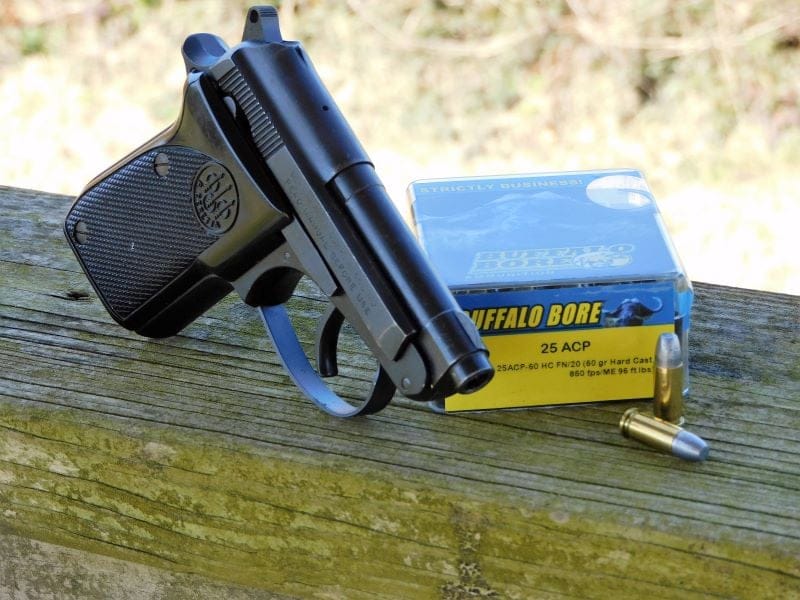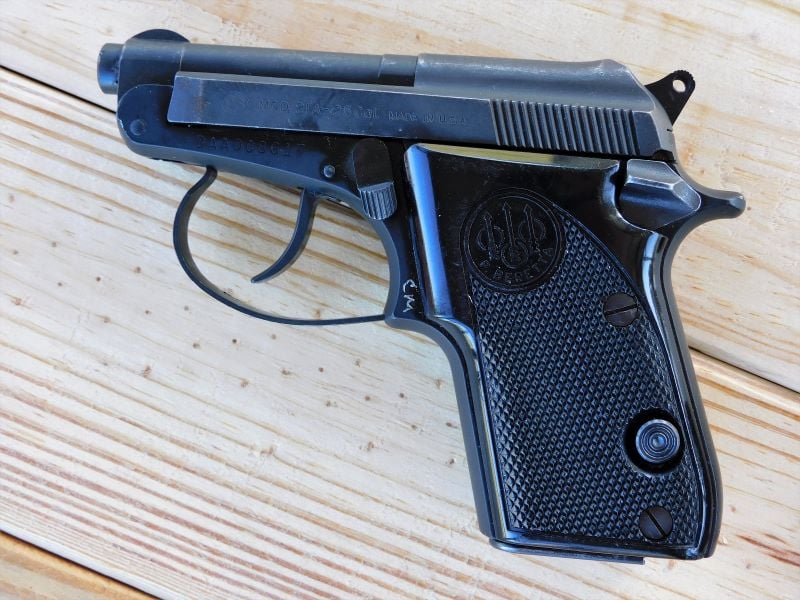The Beretta 21A Bobcat brings class to the pocket pistol, a niche dominated by androgynous polymer single stacks that are hardly distinguishable from one another. On the other hand, it is a .22 caliber artifact of the 1980s that somehow hangs on in the age of the micro-380.
I personally like the appeal of a low-recoil pocket pistol and for a long time, the Bobcat was one of the few that fit the bill. But for several years, I searched for a new model without success. I eventually settled on a used 21A in 22 LR and later acquired the same model in 25 ACP.
In the midst of these purchases, Beretta relaunched the Bobcat during Shot Show 2020. Beretta’s new lineup includes an FDE and a threaded Covert model chambered in 22 Long Rifle. The 25 ACP version is still cataloged by Beretta, but the chambering is notably absent in the remake. That is a shame, since the Beretta 21A in 25 ACP is the best version to make.
Follow along as we shoot the 25 ACP Beretta and compare it to the more popular 22 LR model.

From the Dawn of Time
In “All You Need to Know About the 25 ACP,” I discussed the history and usage of .22 and .25 handguns. Of those makers, Beretta may be the biggest brand behind those rounds. From the 1950s until the early 2000s, the Beretta Jetfire was the firm’s premiere pocket pistol. Available in 22 Short or 25 ACP, the Jetfire held nine rounds, had a short single-action trigger, and a manual thumb safety not unlike a 1911 service pistol. The 22 Short is a rimfire cartridge that has been used since the turn of the 20th century in compact pocket pistols, as has the 25 ACP, which offers centerfire reliability and a bit more power.
In the 1980s, the US military adopted the Beretta M9 double-action pistol and it seemed natural to incorporate that same action to modernize the Jetfire. The Beretta 21A Bobcat made its debut in 22 Long Rifle and 25 ACP in 1984. It was somewhat larger than the Jetfire to accommodate the longer 22 LR case as well as the double-action firing mechanism. When loaded, the pistol could be carried safely with the hammer down and safety off. A long pull of the trigger cocks and drops the hammer, firing the pistol. The slide then re-cocks the hammer for a lighter trigger pull for subsequent shots. This allows the user to have a pistol ready to use without having to fumble a manual safety, yet be carriable as the longer, heavier trigger pull made accidental discharge more difficult.
The Bobcat was among the few .22 and 25 ACP handguns still kicking around in the late 2000s when the 380 ACP made a comeback in small, polymer pistols like the Kel-Tec P3AT and the Ruger LCP. While powerful for their size, micro .380s are hard to shoot well. By the time Beretta reintroduced the Bobcat in 2020, the pendulum had swung back toward a controllable .22, although it is probably the worst defensive option in an autoloading pistol.

Beretta 21A Bobcat Features
The base Beretta 21A Bobcat is a double-action/single-action pistol that outwardly looks like a miniaturized version of the firm’s famous M9/92FS pistol, with visually similar black plastic grips, hammer, exposed barrel, and fixed front sight. The Bobcat is available in either blued carbon steel or Inox stainless steel. Both use a lightweight aluminum frame that is anodized to match.

Aside from these features, the 21A is a functionally different animal. It does not have a de-cocker, but it does have a manual thumb safety on the left side of the frame. The safety can be engaged if you elect to carry the pistol with the hammer cocked. Likewise, the safety can be engaged with the hammer down. The magazine release button is seated flush in the grip, rather than on the side of the grip frame. This prevents the magazine from being released accidentally when the little pistol is holstered or gripped.
Keeping with its bump-free design, the sights are low profile and fixed—a milled rear v-notch and a front blade mounted at the end of the 2.4-inch barrel. The barrel itself is also fixed in place on firing, as the Bobcat is a straight blowback pistol that relies on gas pressure to throw the empty shell out and cycle in the next round from the magazine. Because of that, there is no need for an extractor. Indeed, an extractor would get in the way of the most appealing feature of the Bobcat—the tip-up barrel.
Little pistols like the Bobcat have small slides and stout recoil springs, which do not make them quick or easy to rack. With the Bobcat, you do not have to rack the slide to chamber a round. A forward sweep of the lever on the left side of the pistol allows the barrel to open up so you can insert your first round directly into the chamber before closing the barrel. The tip-up barrel Berettas like the Bobcat are often recommended for prospective concealed carriers with hand problems, never mind that the 22 Long Rifle and the 25 ACP are on the light side in terms of power.
On the Range
The Beretta 21A is a pistol that I have a lot of fondness for. The Bobcat is aesthetically pleasing to look at and it is chambered in softer-shooting cartridges that should be easier to hit with than a comparable 380. But leaving that aside, actually shooting the Bobcat is a mixed bag that left me gun-shy when going from the .22 to the .25, respectively.
The Bobcat in 22 LR has a lot going for it. It is not any less powerful than the 25 ACP, but the cartridge is inexpensive to locate and shoot. At the time of this writing, I can get a box of fifty rounds of 22 LR at any sporting goods store for $5. A similar box of 25 ACP rounds will cost me $30 and availability is spotty. Due to the sheer popularity and availability of the cartridge, the 22 LR Bobcat is, by far, the most common you are going to find and probably the reason Beretta revived the model in that caliber.
On the range, the Beretta Bobcat in 22 LR is fairly accurate. In spite of its low, small sights, I could place eight rounds into a palm-sized group at ten yards off hand. Even out of a small gun like this, recoil from the 22 is nonexistent. I dare say, shooting the Bobcat is pleasant, until you get dud rounds or other malfunctions. The Bobcat in 22 LR is finicky when it comes to ammunition. The 22 LR is prone to ill-distribution of the priming compound of the rimfire case and dud rounds. The bullets themselves are coated in wax, which only adds to the residue that builds up inside the pistol once fired. In any given range session, it was hard to get through a box of 100 rounds without a malfunction as the pistol became dirty. I had my best luck with CCI Mini Mag and CCI Stinger hypervelocity loads, but even these fail to fire on occasion.

The worst part of the Beretta 21A is how you clear these malfunctions. Because the Bobcat has no extractor, you cannot remove a faulty round by drawing the slide rearward as instinct would tell you to do. Hitting the barrel release will allow the barrel to tip up, sending the errant round flying out of the chamber. That is the best-case scenario if the pistol is relatively clean. After a good shooting session, be prepared to clear malfunctions with a pocket knife.
Needless to say, I did not have high hopes when I tricked myself into ponying up the cash for yet another Beretta 21A—this time in 25 ACP. It looks and operates the same as my 22. But the shooting experience is night and day. The 25 ACP Bobcat will give you 8+1 rounds of ammunition, compared to 7+1 with the 22.

It has the same 13-ounce loaded weight. Felt recoil is identical. The 25 is equally accurate as I could easily put nine rounds into a few inches at 10 yards. At 25 yards, I had to aim a few inches over my aiming point to drop those rounds into the bullseye. The trigger pull weight in both double action and single action gives a crisp break. The single action pull breaks at 3½ pounds on my Lyman trigger scale after some take-up. The double-action pull is eight pounds with no snagging, not unlike a good double-action revolver trigger. The pull weight was a bit heavier with the 22 as the hammer spring needs to be stronger in order for the hammer to smack the rimfire case and set the ammunition off reliably. But it was on reliability where the picture became more clear.

Range session after range session came and I waited for a malfunction that simply did not happen. After three hundred rounds down the pipe without any cleaning, there was never a dud round or a failure to cycle. From conventional 25 ACP 50-grain FMJ loads to lighter 35-grain hollow points like the Hornady Critical Defense and Fiocchi Extrema, the 21A 25 ran them like a top. The 25 ACP cartridge uses a conventional non-lubricated copper-jacketed bullet and is centerfire, not rimfire. This translates to better reliability, and it is the chief advantage of the 25 ACP cartridge, even with the best 22 LR loads out there today. Although I never got an errant round with my 25, I did simulate a few malfunction drills. The 25 caliber Bobcat still does not have an extractor, but tipping the barrel allowed loaded ammunition to fly clear.
Parting Shots
I admit to being somewhat of a fan of the little 25 ACP cartridge. I also freely admit I am probably in the minority of people who have anything good to say about it. By today’s standards, it is underpowered as a self-defense cartridge and the few pistols still made that chamber the round are roughly the same size as a more powerful 380 micro gun. However, the same can really be said for the 22 LR.
Aside from availability, the .22 is not any more powerful than the .25 and it certainly is not more reliable. Yet the micro .22 has made a comeback as an alternative to the heavy-hitting, palm-smacking 380 when the 25 ACP is the best low-recoil alternative. Owning and shooting a pair of Beretta Bobcats in 22 LR and 25 ACP side by side makes the difference obvious. While a quality handgun in 22 LR has its place, the makers of the new generation of micro pistols may be investing too much into a rimfire when an age-old alternative is better suited.

